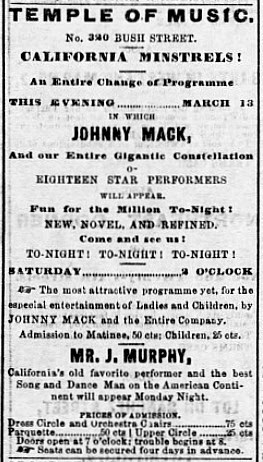It opened November 3, 1865 as Congress Hall. The theatre was on the north side of the street between Montgomery and Kearny. Across the street was the Bush St. Theatre, a house that had opened as the Alhambra.
Seating: 900 in later years. The capacity of the main floor and dress circle was 500. There was also a balcony, called the family circle.
It had become the Temple of Music by the time of this ad that appeared in the March 13, 1868 issue of the Daily Alta California:
On June 30, 1873 William Shiels reopened the theatre as Shiels' Opera House. Thanks to Jack Tillmany for finding this item about the event. Jack found a mention in the book The San Francisco Stage noting that Shiels had spent $30,000 rebuilding the theatre.
On April 10, 1873 Shiels leased the theatre to A.M. Gray and it briefly became known as Gray's Opera House. On October 20, 1873 Gray sub-leased it to Tom Maguire. In the 1874 and 1875 city directories it's listed as Maguire's Opera House.
An ad from the 1874 Langley city directory for the Opera House, not to be confused with Maguire's Opera House on Washington St., a venue that closed in 1873 to make way for what is now called Columbus Ave. Thanks to Mark Reed for the post of the ad as a comment on the San Francisco History Facebook page. His post was about, among other things, African-American entertainers, Dashaway Hall (139 Post St.), the Palace Hotel, and more.
An 1874 program from the theatre as the Opera House appearing on Calisphere from the Museum of Performance and Design Performing Arts Library.
This March 1877 article discusses Maguire's financial problems both at this venue and at the Alhambra across the street, known as Maguire's New Theatre and later as the Bush St. Theatre. He ended up relinquishing both these houses as a result of the financial reverses he suffered in the 1877 Comstock crash. Thanks to Jack Tillmany for finding the article.
At the time, Maguire was also operating the Academy of Music, later known as the Baldwin Theatre, on Market St. at Powell. Lawrence Estevan discusses the career of Maguire in detail in his "Tom Maguire; Dr. David G. (Yankee) Robinson; M.B. Leavitt," completed in 1938 as part of a Works Progress Administration project. The copy in the collection of the San Francisco Public Library is reproduced on Internet Archive. In his chapter titled "A Deal With 'Lucky' Baldwin," he comments on Maguire giving up the two theatres on Bush St.:
"But the trend was still downward and Tom Maguire could decipher the handwriting on the wall in 1877. After spasmodic offerings at his three theatres during the first months of the year, he announced retrenchments. On April 1st he reported that his Opera House had been leased to Billy Emerson on a two-year lease, and was to be known as Emerson's Opera House. Here Emerson opened on April 23, offering his minstrels. On April 1st it was announced that the Alhambra was also to be re-titled. The Bush Street Theatre opened on April 7 under the management of Titus and Locke. The first offering was burlesque by the Salisbury Troubadours.
"The Shut-Down of Baldwin's - Baldwin's Academy had closed ingloriously by April,
and young Belasco, former right-hand man of Maguire, had in
February been enlisted by a new variety house known as
Egyptian Hall to write, direct, and act in specialty plays in
conjunction with 'illusions.' Maguire was deserted by fortune and the public. On and off, however, Maguire continued to produce
plays at the Baldwin until 1882. During this period the relations between Maguire and Baldwin became more and more
strained. Baldwin was forced to cover heavy losses at the
theatre and Maguire was continually gambling in an effort to
keep the enterprise going. Baldwin finally withdraw his
support and Maguire's management was at an end. From that time until his death in 1896, his activities in the theatre
world became increasingly negligible."
What had been Shiels' Opera House and later Maguire's Opera House was listed as Emerson's Opera House in the 1878 city directory.
Emerson evidently was around for less than a year. The venue had another big reopening on October 28, 1878, this time as as the Standard Theatre. Thanks to Jack Tillmany for finding the article.
This item about the theatre appeared in the 1881 publication Doxey's Guide to San Francisco, available on Google Books. They seem to be overstating the time Emerson had his name on the theatre. On an 1882 theatre list and in the 1889 San Francisco Blue Book the theatre is listed with an address of 320 Bush.
A seating chart for the main floor and dress circle from the 1884 Social
Manual of San Francisco. Thanks to Glenn Koch for the photo from the
book in his collection. The pricing at the time was $.50 and .75 on the
two lower levels and $6.00 and $8.00 (!) for the proscenium boxes. The book noted:
Closing: The date is unknown. It was around until at least 1889.
More information: For more about Tom Maguire's career see the pages about the Jenny Lind Theatre on Portsmouth Square, Maguire's Opera House on Washington, the Academy of Music on Pine St., the Bush St. Theatre across the street from the Standard, and the Baldwin Theatre on Market St. at Powell.
The Standard is mentioned by James Madison in a 1926 article titled "San Francisco
Theatrical Memories" that appears on a Virtual Museum of the City of San Francisco page.
Jack Tillmany's Arcadia Publishing book "Theatres of San Francisco" can be previewed on Google Books. It's available from Amazon or your local bookseller.
| back to top | San Francisco Theatres: by address and neighborhood | alphabetical list | list by architect | pre-1906 theatre list | home |










No comments:
Post a Comment